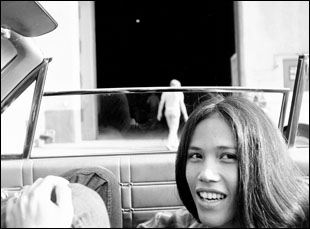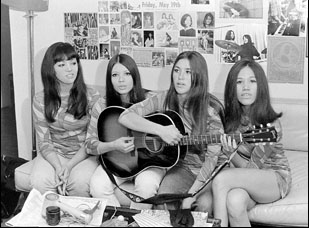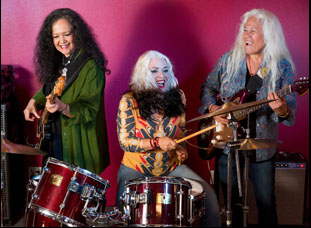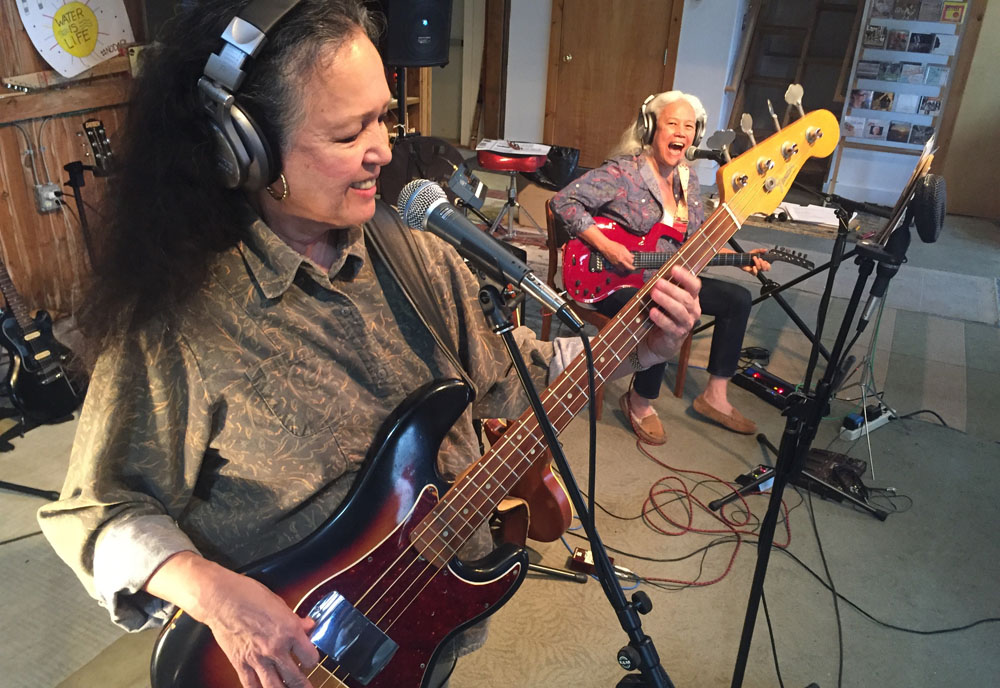Bobbi Jo Hart was looking up guitars for her daughter to practice on as she learned how to play when she was startled to learn something herself.
“I was on a guitar website and there was a section called “Stories” and I just clicked on it and up pops this amazing photo of June Millington, grey-haired long and wielding an electric guitar,” said the director of “Fanny: The Right to Rock,” who would soon enough be scrolling through the discography of Millington’s groundbreaking band Fanny. “I just started reading about her and Fanny and their legacy and was blown away like most people are when they discover them. I was equally excited and thrilled to discover this band, but also really pissed off that I didn’t know about them.”
While disappointment set in that there were no Fanny albums among her parents’ considerable vinyl collection in the 1970s, Hart’s anger may have been the ideal way to start listening to Fanny, an act that began with sisters June and Jean Millington on ukuleles as kids to ingratiate themselves at predominantly caucasian schools where they felt like outsiders at because of their Filipina heritage and graduated to electric guitars, opening for Humble Pie and Deep Purple. The band would come to include drummer Alice de Buhr, keyboardist Nickey Barclay and percussionist Brie Brandt, setting themselves apart as a rare all-female rock act with a distinctive sound yet feeling isolated for those very same reasons, sold on their sex appeal rather than their music and forced to make concessions to a male-dominated industry such as letting Brandt go when their manager told them it would be difficult to tour as a band of five.
After their story had been largely told through such a skewed perspective during their rise, Hart offers something of a corrective as the band reunites for their first album in nearly 40 years, “Fanny Walked the Earth,” and for the first time is able to share many of anecdotes they were often discouraged from during their initial press rounds, whether it was speaking to their gender, sexuality or the racism they encountered. Accompanying the candid recollections are vivid snapshots taken at the time by the photographer Linda Wolf at what became known as Fanny Hill in Los Angeles, a former home of Hedy Lamar overlooking the city where the band recorded and smoked hash with Mick Jagger and Bobby Keys, and “Fanny: The Right to Rock” precisely summons the era the band was a part of while showing how ahead of the time they were, laying the groundwork for such acts as The Runaways and the Go-Gos, whose members appear in the film. With “Fanny: The Right to Rock” set to hit the road once more, where some screenings will be accompanied by musical performances such as the film’s opening night at the Quad Cinema in New York this week, Hart spoke about how everything came together at just the right moment and the excitement of restoring the band to their rightful place in music history.

It was 2015 when I was looking for this guitar for my daughter, and there was no album at the time, so I remember speaking with June saying, “We could do a film that explores the backstory of the band,” intercutting that with interviews of them telling the stories. But I really wanted to do a forward momentum arc and was fascinated by these women who were still rocking out. June was running the girls’ rock camp and I was waiting for something to happen that I still could bookend the film in some ways by following them on a journey today, celebrating these women that at the time I was filming were in their late sixties. There was no album, but we explored the idea of following maybe one of the IMA girls’ rock camps [taught by June], but then there are issues. These girls are younger and they’re going to this rock camp as a place to feel safe and private to explore really intimate things, so we thought well that’s probably not going to work in the way that we’d like to do it.
I was waiting for something to happen with the band and as I was releasing my last film “Rebels on Pointe” about the Ballet Trocodero and traveling to festivals, we lost touch [with the members of Fanny] for a few months and I was just busy promoting that film and our last conversation, June and I were like, if something happens, let’s get back in touch. Then I took my daughter to the women’s march on Washington in January 2017 and I was sitting there with my daughter and Madonna was on stage, and I was looking at the Jumbotron screen and there were all these other women on stage with her. It was just before Madonna was about to perform and I see this woman with this flaming grey hair standing behind her and I’m like, “Oh my God! That’s June!” I try to call her, but of course, there’s a million phones there and you couldn’t do anything because there were way too many people trying to do it at the same time, but later that night, I got a hold of her and she was already leaving DC, but she mentions, “Hey, by the way, guess what? We got a new rock record deal and three of the Fanny bandmates are getting together. We’re starting to record in three weeks.” And I was like, “What?!?!”
I had to work really fast and found Claire Sanford, an amazing director of photography, and she and I just jumped in a car with gear. I hadn’t even met any of the bandmates in person and the day we drove up to IMA was the day I met June, Jean and Brie, the first time in person and we filmed all week with them as they just got together and started recording that album, so that was the very beginning of our filming with them. I had to catch that lightning in a bottle and luckily, Katherine Buck of Cineflix Productions is a very good friend of mine and she really loved this story, so she and her partner Glen Salzman made a crucial contribution at a time when I desperately needed it to get this film off the ground, so I was able to capture it and follow that story.

I admit I was really fangirling when I met them. I had to get over that first because just meeting this legendary band was such an honor. But then in terms of learning about their stories, when you look back at the articles, nobody was mentioning that there were women in the band who were in the LGBTQ community or that they were Filipina Americans. It was just this all-girl band and there were some great journalists, but even the journalism that was great at the time focused on how they wrote their own songs and were really great players, but I find that they missed just the layers of the background. When you’re discovering a band, you want to know where they come from, how did they learn their instruments, how did they get that tone and it’s like Jean says in the film, a journalist would often say, “How does it feel to be a girl playing an instrument?” It was so one-dimensional in terms of the questions that they would get, which the male musicians would have laughed the journalist out the door.
So it felt amazing to give the band a platform to share their story because I really consider the film a collaboration with them and I just tried to catch [their story] as well as I could and just listen. And you could easily do a TV series to try to capture the layers of this story and there’s only so much you can capture in a 90-minute film. That was frustrating for me and I think frustrating for the band in some ways too because they want as much to be told as possible, but I’m honored that they all seemed to really enjoy the film and feel that it honors them. It was a long haul to get the film made like so many documentaries, but so worth it, and I consider it a slow burn of a project, but it’s been a slow burn to get Fanny recognized too, so they kind of go together.
There’s so much energy in the film. Was there a particularly fun sequence to put together where you’re getting across all the information you need to get in with that music behind it?
My editor Catherine Legault was phenomenal. I worked with her on “Rebels on Pointe” as well, and she’s also a musician herself, so it really helped and we spent months and months on the editing of this film. Then when COVID hit, we had a little bit more time because I just couldn’t stomach it after all these years of trying to bring public attention to Fanny and not having them in the audience, not performing at some of these events [as we started screening the film]. I just couldn’t do it. So Hot Docs and some of the other festivals were really amazing about postponing the release of the film until 2021.
I loved working with the black-and-white footage of the band playing live on French TV. They were kicking ass in that footage and of course, archives are so bloody expensive, you can only afford so much but I tried to put as much of it as I could to show how raw and rocking they were, which as the band will surely tell you, wasn’t quite captured the same way on the albums. The albums were amazing, but I do feel they could let them loose a little more to really rock out and not try to tame them a bit, so that was really fun to work with and I also really love when Brie and Alice are playing double drums together, which was really meaningful because they had never played together and then there’s that scene of just all these women coming together in the recording studio — Cherie Currie and Alice Bag [among others] that have been part of music history and The Go-Gos and The Bangles sent in background vocals for that album as well [when] they couldn’t be there in person.

Yeah, we were at DOC New York last November and it was amazing and it was so well-received and people were just rocking out. Some of the girls from the IMA Rock Camps came up on stage, which may happen for the theatrical premiere that’s coming up May 27th in New York and then L.A. and across the U.S. To be in the theater and see the film and then to see on stage, June Millington, lead guitarist for Fanny and then she leaves the band and then Patti Quatro replaces her for that fifth album “Rock and Roll Survivors” and [now] the two of them will be playing on stage together after the film in New York, bringing them together — these different Fannies as they affectionately call themselves since the film came out — is just so amazing. I really hope a record company picks up and does a new album with them or rerecord some of their songs. There’s five incredible albums from the ‘70s, and I hope people pay attention to the new album “Fanny Walk the Earth” because it’s recent incarnation didn’t get promoted as well as they would’ve hoped, given the health issues that Jean faced. But they’re here, they’re rocking, and I’m getting really pumped to drive down to New York for this theatrical premiere.
“Fanny: The Right to Rock” will air on May 22nd on PBS and will stream thereafter on PBS.org and the PBS app.




